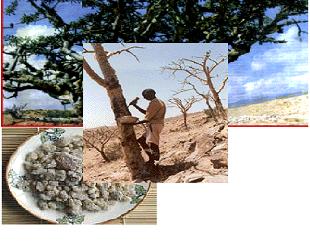To produce the frankincense resin, a vertical slot is cut and at the end the stem is peeled a little, the milky resin hardens on the tree, the slot is deepened and after about three months a yellowish spherical lump solidifies at the bottom of the slot - frankincense resin. This way of production makes it difficult for the tree to continue developing

Many of the trees from which different products are produced without dying, well-known and well-known products are: cinnamon - extracted from the bark of a tree, rubber - extracted from resin and of course all the fruit trees. The more expensive products are those used for perfumery: myrrh = the resin of the commephora, sandalwood and cinnamon = powder from the stem bark,
The best known and widely used even today is the frankincense resin that is extracted from a tree (frankincense). Its botanical name is frankincense / Boswellia (about five different species) and it originates from the Horn of Africa and the south of the Arabian Peninsula.
In ancient times, the important trade route that connected the East to the West passed through our territory, a route known today as the "Perfume Route" because the most important products that were transported along the route were types of perfumes, the most important of which was frankincense resin, the same resin that when burned produces a pleasant smell. As such, frankincense resin is still used today, in the East (India and China) in the perfume industry, in celebrations and ceremonies in the Arab world, in the homes of the Sultanate of Oman, in all of which burning frankincense is common and accepted. In the Western world, frankincense resin is found mainly in churches, since according to the New Testament, frankincense resin was among the gifts brought to Jesus (the baby) by the "Three Wise Men". (along with myrrh and gold).
The priests wave vessels with hot coals and frankincense resin on them. It is understood that these days, during Christmas (the birthday of Jesus) and New Year's (the word of Jesus), there are more and more frequent visits to the churches, the crowding increases, the need for "air-purifiers" is great and therefore the demand for resin Turns out, maybe this is the reason for the publication of a study that examines how resin extraction affects the trees. This is one of the few times that the (quantitative) effect of extracting resin from trees in general and from frankincense trees in particular has been tested, therefore there is great interest in the findings.
To produce the frankincense resin, a vertical slot is cut and at the end the stem is peeled a little, the milky resin hardens on the tree, the slot is deepened and after about three months a yellowish spherical lump solidifies at the bottom of the slot - frankincense resin.
Prof. Frans Bunger from Wageningen University in the Netherlands publishes his research in the Journal of Applied Ecology, the professor is helped by a researcher from Eritrea to check the extent of the damage caused to trees when they are wounded to extract the resin. Until today it was accepted that scraping the bark of the trunk or wounding for the purpose of extracting resin does not harm the trees, provided that the extraction is moderate...? The researchers found that: due to the high demand for frankincense resin at the end and beginning of the Christian year, carvers produce more grooves in each tree and produce more resin, the result is that the same trees bloom less flowers, give less fruit, fewer fruits spread less seeds which causes damage to the regeneration of the frankincense tree population in places in which there is a lot of resin production,
The researchers assume that the trees divert too many carbohydrates for the production of resin, carbohydrates that are lacking for the regular development of the tree and for the production of flowers - fruits - seeds. The result is that in the areas where the resin is extracted there is no regeneration and the groves of frankincense trees are rapidly dwindling.
In order to prevent damage to the "branch" of resin production, the researchers suggest reducing the number of slots in each tree, in their opinion, six slots in a tree (which is the accepted number) are too many, (the researchers do not recommend the desired number of slots), the researchers also recommend giving the trees periods Rest, i.e. years in which no resin will be produced, the overall result will be (of course) producing less resin.
Because of the growing demand for frankincense resin, without a proper (sustainable) production regime, the poor producers of their future are literally cutting down the industries from which they live. In addition to this, although the frankincense trees grow in rocky and relatively poor soils, more and more woods are being cut down to make way for agricultural areas, so it is necessary to properly manage the wild areas where the trees grow.
According to the researchers: "If Jesus had been born in our day, it is possible that the "three wise men" would have been forced to look for a substitute for frankincense".
Dr. Assaf Rosenthal, tour guide/leader in Africa and South America. For details, phone 0505640309 / 077-6172298, email assaf@eilatcity.co.il

4 תגובות
Good article
I would like to join a trip to Africa to visit the myrrh and frankincense growing fields during the incense collection period.
Please contact me by email.
Thank you Tamara
Where can I buy the body cream?
Where can you buy the perfume?